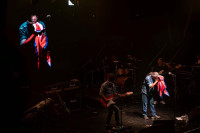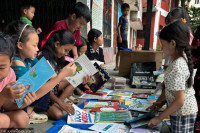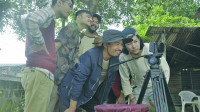Entertainment
The people’s superstar helps the people
Rajesh Hamal, arguably the biggest superstar in the Nepali film industry, was in Paris when the April 25 quake hit.
You were in Paris during the Great Earthquake of April 25. What was your reaction?
I was in my hotel room in Paris. It was seven in the morning there. A Nepali family living in France called me up and told me that Dharahara had collapsed. I was shocked. I tried to call home—for an hour—but I couldn’t get through. And in the absence of information, my imagination ran riot. I thought Ason, Indra Chwok and other densely packed areas in that neighbourhood had been totally destroyed. I thought that maybe there would be a hundred thousand casualties at least, because an exporter had once told me that those areas were very vulnerable to earthquakes. I was also worried about my wife, Madhu. I wasn’t too worried about my brother and sister because they live with their families.
What did you do next?
I had a programme in Paris on Sunday, and there was a list of programmes scheduled for various cities in Europe. I had my return ticket for May 7. I called everything off, although these programmes had been scheduled nearly a year ago. From the second day onwards, we focused on collecting relief materials at the Nepali Embassy in Paris. I spent four days in France. Then I went to the Netherlands and Finland to collect donations from the NRNs living there.
How did the people react there to the news of the earthquake?
All the Nepalis were united, and everyone wanted to help in whatever way possible. And all the major channels—the BBC, CNN and others were featuring Nepal-related news 24/7. Even the local channels were constantly updating details about Nepal.
How did you collect the funds? How was it mobilised?
We raised money through embassies, and it was transferred directly into the Prime Minister’s Relief Fund. The money came to Nepal through various NRN chapters.
In the Netherlands, I heard about a citizen-run organisation that was already collecting funds from all across the country through a relief programme called Giro555. They appealed for funds on local TV and radio shows. They even invited me to come speak on their popular nightly TV talk show and talk to the audience about Nepal and the quakes. They collected about 9.6 million euro in one day alone. This money was sent to Nepal through various INGOs and NGOs.
Do you think that money mostly went to the quake victims?
I am really unhappy about how the money was channelled; I don’t know whom we can trust anymore. I have been looking at how the money collected was being channelled through NGOs and INGOS. I have learned that about 75 percent of the money is spent only on their staff. Only 25 percent, it seems, is being used on the affected people.
Have you been involved in relief-distribution programmes at home?
Yes, I have been working with a small team around me. Nepalis and non-Nepalis abroad have been sending me money to buy relief materials and distribute them. I recently distributed clothes to quake victims who had been displaced from Langtang; they were taking shelter in Swayambhu. I have also been helping children in orphanages, and I have been participating in various programmes to help cheer up kids living in tents in Kathmandu.
Last week, you were in Pokhara on a tourism-promotion campaign. How did that go?
It was a programme meant to revive the tourism industry. I spent three days in Pokhara, and my job was to assure tourists that Nepal was a safe place to come visit. Many people around the world think that everything has been destroyed here. We have to send the message that Nepal is safe. The tourism sector has been badly hit. Even though hotels are now offering a generous discount, the tourists are still not returning.
What could be the lessons from this quake for all Nepalis?
We need to wake up from our slumber. Earlier, when people talked about the quake of 1934, we did not think that something of that scale could hit us again. We should have been more careful when we were constructing houses around 20 years ago, when many of the buildings in Kathmandu were constructed. And the government should have designed more open spaces.




 6°C Kathmandu
6°C Kathmandu









